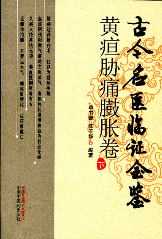
主要责任者: 单书健,陈子华
责任方式: 编著
出版者: 中国中医药出版社
出版地: 北京
字数: 549 千字
页码: 1-407
开本: 32
中图分类号: R249
分辑名:上
语种:中
定价:36.00(上下卷)
出版时间:1999-08
丛书多卷书否:是
丛书名:古今名医临证金鉴
书目简介:本册工具书是古今名医临证金鉴之一,共收录89条词条。
被引频次:12

主要责任者: 单书健,陈子华
责任方式: 编著
出版者: 中国中医药出版社
出版地: 北京
字数: 549 千字
页码: 1-410
开本: 32
中图分类号: R249
分辑名:下
语种:中
定价:36.00(上下卷)
出版时间:1999-08
丛书多卷书否:是
丛书名:古今名医临证金鉴
书目简介:本册工具书是古今名医临证金鉴之一,共收录90条词条。
被引频次:12